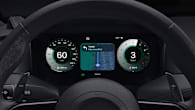What goes around, comes around - and around, and around in the case of rotary engines.
There was a time when some enthusiasts argued that rev-tastic
Rotaries were the greatest thing since the invention of the internal-combustion engine, but they faded from view a few years ago with the demise of Mazda’s award-wining RX-8 sports car.
With the debut of the gorgeous RX-Vision concept at the Tokyo Motor Show, however, rotary engines are back in the spotlight, championed, as ever, by Mazda.
Famed for stratosphericredlines, challenging fuel economy, a thirst for oil and occasional reliability issues, rotary engines have always been a brave, left-field choice.
But is the rotary engine’s reputation as a wallet-crushing exercise in petrol-hedonism deserved? To find out, let’s get to the bottom of what makes a rotary engine tick, or spin.
A Nazi piece of work?
A rotary engine refers to a novel type of powerplant that does away with pistons, valves, camshafts and pretty much everything associated with running a standard engine, paring the entire thing down to just two or three moving parts.
You’ll often see rotary engines described (with a slight snigger) as Wankel engines in reference to Felix Wankel, a German engineer and darkly colourful character.
History tends to gloss over the fact that Herr Wankel was literally a Nazi and concentrates more on his delightfully offbeat engine.
There are other concepts that use the same rotary architecture as Wankel’s ancient design, such as LiquidPiston’s triple-spark rotary, but none have made it past prototype stage so far.
In terms of production cars, the only rotor-based engines have run from Herr Wankel’s blueprints.
How does it work?
Imagine, if you will, a rounded Dorito chip spinning about inside a figure-eight
At a basic level, a rotary engine works on the same principles as most other internal-combustion devices. Fuel and air are drawn into a cylinder, compressed and burned.
That, however, is about where the similarities end. Instead of a piston moving up and down in a cylinder, the rotary engine is, as the name describes, one where a rotor spins, inside a sealed housing. The rotor is shaped much like a triangle, but each face of the triangle is slightly convex.
The housing is basically oval-shaped, with small indentations in the middle of each long edge, giving it what’s known as an epitrochoid shape.
Imagine, if you will, a rounded Dorito chip spinning about inside a figure-eight.
The ingenious bit comes from the way that the rotor rotates inside the chamber. Instead of spinning on the spot, the rotor follows an eccentric path around the housing, creating three separate sealed-off areas as it moves.
This is the most important part of how rotary engines work. It means that each time the rotor rotates, it creates three separate combustion chambers. So a twin-rotor setup, like the one Mazda fitted to the RX-8, is comparable to a six-cylinder piston engine.
What are its benefits?
It sounds complex, but the Wankel rotary is actually an incredibly simple engine, compared to piston-based affairs.
In a single-rotor setup, there are just two moving parts – the rotor and the output shaft. For a twin-rotor setup, there are only three. Keep in mind that for a small, cheap four-cylinder piston engine, there are intake and exhaust valves, connecting rods, pistons and at least one camshaft, adding up to around 40 moving parts.
The simplicity of the rotary design means low weight and a compact block, both of which play exceptionally well in car design. Less weight means better handling and – theoretically – better fuel economy.
Rotary engines are renowned for being free and high-revving; the 1.3-litre rotary fitted to Mazda’s RX-8 had an enforced limiter at 9400rpm, not because the engine couldn’t handle any more, but because the clutch plates would actually disintegrate at anything higher.
The revs are actually measured at the output shaft, which spins three times faster than the rotor. The rotor’s internal toothed gear is much larger than the output shaft’s external toothed gear, so for each rotation of the rotor, the output shaft rotates three times.
This means that when the RX-8 tachometer is screaming along at 9000rpm, the rotor is only spinning away at a lazy 3000rpm. Genius.
Because the rotary engine can run its driveshaft at such high speeds, it can create a fair whack of power in the process. For example, the naturally aspirated 1.3-litre fitted to the RX-8 makes 170kW, and weighs just 120kg.
For a comparison, Honda’s similarly powered – and brilliant – four-cylinder VTEC engine, as found in the now defunct S2000, weighs 55kg more.
The power delivery is smoother and more constant, as well as more reactive to throttle inputs
Rotary engines are also smoother than their piston-based brethren. In traditional engines, the pistons oscillate rapidly, even at idle. The constant toing and froing of the pistons creates high-speed vibrations that take serious engineering work to overcome, such as counterweights, balance shafts and harmonic balancers.
The rotary is different; because all of its motive force rotates constantly, in one direction, there are fewer essential imbalances to correct. The result is incredible smoothness that’s unmatched by conventional piston engines.
And because the rotary engine has three combustion cycles for each rotation, the power delivery is smoother and more constant, as well as more reactive to throttle inputs.
So why doesn’t everyone use them?
A common complaint with rotary engines is their low torque, but that isn’t really accurate. Mazda’s biggest ever road-legal rotary was a mighty twin-turbo 2.0-litre triple-rotor with 402Nm, as fitted to the last-generation Eunos Cosmo.
The standard fare for the non-turbo RX-8 was a piddling 1.3-litre that still managed to pump out 211Nm.
That said, for all the fuel they were using to get it, maybe RX-8 owners were right to complain. Because of the way rotary engines work, they tend to return abysmal fuel economy and, by extension, exhaust emissions.
The long, flat combustion chamber created by the rotor results in an inefficient burn, which wastes fuel.
Over the years, Mazda has championed the development of clean-burning, fuel-efficient rotary engines, but even its most advanced design to date still ran foul of Euro 5 regulations. Oil use was also an issue for RX-8 owners.
Constant and consistent failures in early, underdeveloped rotary engines have created a stigma that’s hard to shake
Mazda hasn’t revealed yet how its new project will beat this problem, but it could be something as super advanced as laser ignition. Or alchemy.
Reliability is also a big concern, with failures of rotor seals causing many of the faults. Without proper seals, the combustion chambers leak into each other and render the engine all but useless.
When the seals go, it’s time for a full engine rebuild. In fairness, the same applies with piston rings in a traditional engine, but constant and consistent failures in early, underdeveloped rotary engines have created a stigma that’s hard to shake.
What’s the future of the rotor motor?
Since its first use in the NSU Spider and Ro 80, the Wankel rotary has had a difficult development. NSU, a German car manufacturer that first championed the rotary engine, was actually quite rubbish at getting the thing to work. Extremely important seals on the rotor tips failed repeatedly; the resulting warranty claims and bad publicity sent NSU to the wall and tarnished the name of rotary engines for decades.
Manufacturers from Alfa Romeo to Rolls-Royce have toyed with Wankel rotary engines; yet all but Mazda have pretty much given up.
Small engineering firms are coming up with novel rotary engines that promise to do away with the traditional shortcomings of the Wankel engine.
Mazda, on the other hand, is hell-bent on proving the concept can work in the new age of snowballing complexity.
Mazda says there’s a future for the rotary as a standalone power source. Unless Mazda’s boffins can solve the dismal economy, it’ll remain a niche product, but don’t count them out; they’ve done it before.
And the RX Vision concept certainly looks the goods.







.jpg)

.jpg)



.jpg)





